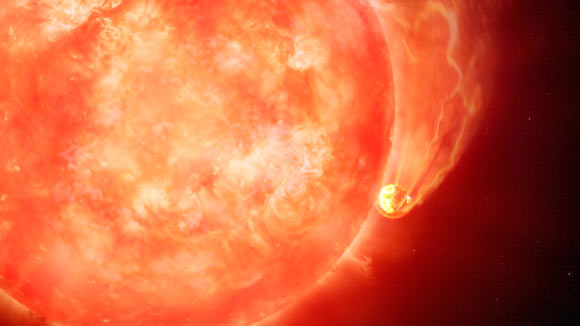At the end of their main-sequence life span, stars similar in mass to our Sun will undergo a period of evolution. This stellar evolution is predicted to influence the population of planets around them. As the star expands during its post-main-sequence evolution, astronomer expect a large fraction of the exoplanets discovered so far to be engulfed by the expanding star.

An artist’s impression of a Sun-like star engulfing a giant exoplanet. Image credit: International Gemini Observatory / NOIRLab / NSF / AURA / M. Garlick / M. Zamani
Using data from NASA’s Transiting Exoplanet Survey Satellite (TESS), astronomers Edward Bryant and Vincent Van Eylen looked at 456,941 stars that had just entered the post-main sequence phase.
They used computer algorithm to search for the repeated dips in brightness that indicate an orbiting planet is passing in front of the star, focusing on giant planets with short orbital periods (i.e., that took no more than 12 days to orbit their star).
They identified 130 planets and planet candidates, including 33 that were previously unknown, orbiting closely around these stars.
They found such planets were less likely to occur around stars that had expanded and cooled enough to be classed as red giants (i.e. that were further on in their post-main sequence evolution), suggesting many of these planets may already have been destroyed.
“This is strong evidence that as stars evolve off their main sequence they can quickly cause planets to spiral into them and be destroyed,” said Dr. Bryant, an astronomer at University College London and the University of Warwick.
“This has been the subject of debate and theory for some time but now we can see the impact of this directly and measure it at the level of a large population of stars.”
“We expected to see this effect but we were still surprised by just how efficient these stars seem to be at engulfing their close planets.”
“We think the destruction happens because of the gravitational tug-of-war between the planet and the star, called tidal interaction.”
“As the star evolves and expands, this interaction becomes stronger.”
“Just like the Moon pulls on Earth’s oceans to create tides, the planet pulls on the star.”
“These interactions slow the planet down and causing its orbit to shrink, making it spiral inwards until it either breaks apart or falls into the star.”
“In a few billion years, our own Sun will enlarge and become a red giant,” said Dr. Van Eylen, an astronomer at University College London.
“When this happens, will the solar system planets survive? We are finding that in some cases planets do not.”
“Earth is certainly safer than the giant planets in our study, which are much closer to their star.”
“But we only looked at the earliest part of the post-main sequence phase, the first one or two million years of it — the stars have a lot more evolution to go.”
“Unlike the missing giant planets in our study, Earth itself might survive the Sun’s red giant phase. But life on Earth probably would not.”
The team’s paper was published October 15, 2025 in the Monthly Notices of the Royal Astronomical Society.
_____
Edward M. Bryant & Vincent Van Eylen. 2025. Determining the impact of post-main-sequence stellar evolution on the transiting giant planet population. MNRAS 544 (1): 1186-1214; doi: 10.1093/mnras/staf1771







